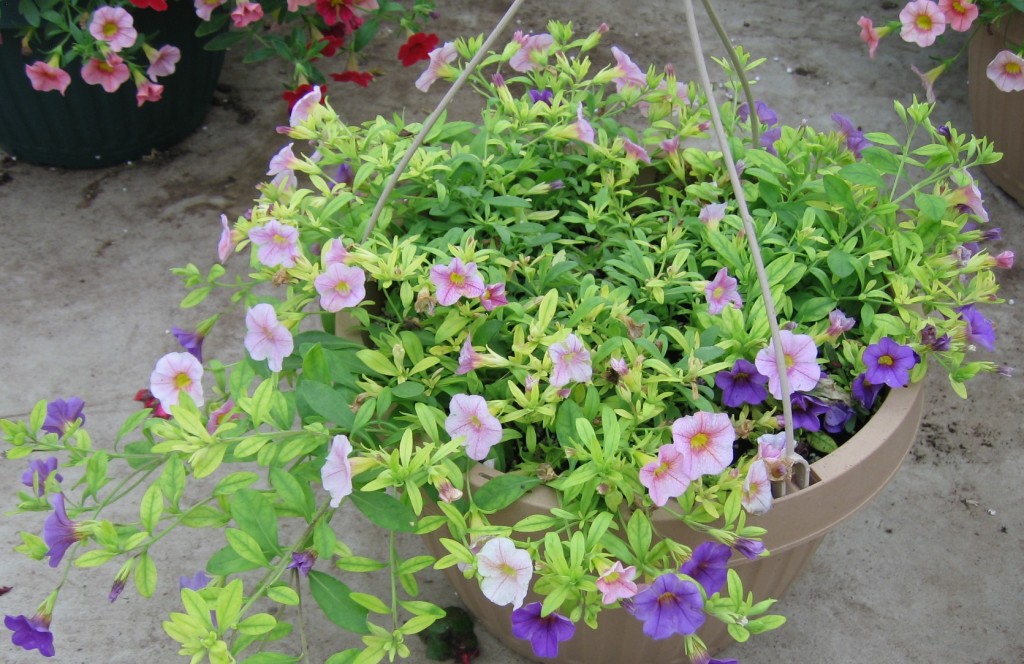
Greening Up Calibrachoa & Petunia
Many popular spring garden plants, such as calibrachoa and petunia, perform best at a low media pH, around 5.4 to 5.8. When the pH becomes too high, above 6.2 for these crops, iron in the root zone becomes less available to these plants. The most common symptom of a high media pH is light green or yellow color between leaf veins, which is referred to as interveinal chlorosis (Figure 1). If the media pH continues to rise, the symptoms become more severe and can include bleaching of the newest leaves and leaf necrosis (tissue death). Once necrosis occurs, the only remedy is to grow new, healthy leaves to cover the damage.
Maintaining a desirable media pH should be one of the most fundamental goals for a grower. Simple in-house media tests should be conducted weekly to determine the pH and electrical conductivity (EC) for various crops. Over time, a change in these values can alert a grower to take small corrective actions to reverse undesirable trends. For example, if the media pH increases above the desired range, the type of fertilizer could be changed to one that has a more acidic reaction (with more ammoniacal nitrogen), or acid could be injected (or increased in dosage) to the irrigation water to reduce its alkalinity. Testing EC is important because chlorosis may also result from inadequate fertilizer, which will lead to a low EC.
Unfortunately, routine in-house soil testing is still not that common among commercial growers. Therefore, media pH problems usually become evident when crops show symptoms, which in most cases were several weeks in the making. When the symptoms are moderate in severity, a corrective action needs to be taken in an attempt to make the crop saleable. Although a high media pH is the most common cause of plant chlorosis, a poor root system or a root disease such as Pythium can also be to blame. Therefore, examine the roots and test the media pH before proceeding with corrective actions.
If the media pH is high and a quick fix is needed, one effective option is to add iron as a substrate drench. Iron EDDHA is the most effective form of iron because it is soluble regardless of pH. Some of the products that contain iron EDDHA are Sequestrene 138 and Sprint 138. A suggested drench application rate of iron EDDHA is 5 ounces per 100 gallons of water, which provides 22 ppm of iron. This solution should be applied with generous leaching, followed immediately by rinsing off the foliage to avoid leaf burn. A single application typically “greens up” plants within a week. If needed, a second application can be made.
Not all forms of chelated iron are equally effective when the media pH is high (Figure 2). EDDHA is soluble at a wide pH range, iron DTPA is less soluble at a high pH, and iron EDTA is even less soluble. Therefore, iron EDDHA is the preferred form, and generally iron EDTA is marginally effective unless pH is below 6.2.
In addition to calibrachoa and petunia, crops that perform best at a low media pH include bacopa, diascia, lantana, nemesia, pansy, scaevola, snapdragon and vinca. If these plants become chlorotic, you can follow the same pH reduction strategies and/or apply an iron-EDDHA drench to produce higher-quality crops. Be careful not to apply iron to iron-efficient crops that grow best at a high pH (above 6.0), such as marigold and geranium, because that can lead to irreversible iron toxicity.


 Video Library
Video Library 




















